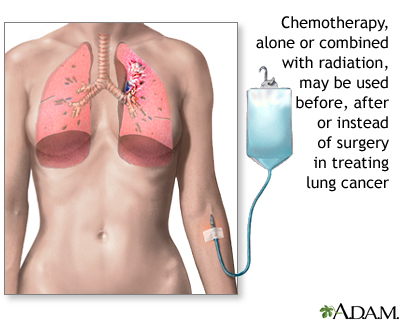There are different types of treatment for patients with small cell lung cancer.
Different types of treatment are available for patients with small cell lung cancer. Some treatments are standard (the currently used treatment), and some are being tested in clinical trials. Before starting treatment, patients may want to think about taking part in a clinical trial. A treatment clinical trial is a research study meant to help improve current treatments or obtain information on new treatments for patients with cancer. When clinical trials show that a new treatment is better than the standard treatment, the new treatment may become the standard treatment.

Clinical trials are taking place in many parts of the country. Information about ongoing clinical trials is available from NCI Web site. Choosing the most appropriate cancer treatment is a decision that ideally involves the patient, family, and health care team.
Three types of standard treatment are used:
Surgery
Surgery may be used if the cancer is found in one lung and in nearby lymph nodes only. Because this type of lung cancer is usually found in both lungs, surgery alone is not often used. Occasionally, surgery may be used to help determine the patient’s exact type of lung cancer. During surgery, the doctor will also remove lymph nodes to see if they contain cancer. Laser therapy (the use of an intensely powerful beam of light to kill cancer cells) may be used.

Even if the doctor removes all the cancer that can be seen at the time of the operation, some patients may be given chemotherapy or radiation therapy after surgery to kill any cancer cells that are left. Treatment given after the surgery, to increase the chances of a cure, is called adjuvant therapy.
Chemotherapy
Chemotherapy is a cancer treatment that uses drugs to stop the growth of cancer cells, either by killing the cells or by stopping the cells from dividing. When chemotherapy is taken by mouth or injected into a vein or muscle, the drugs enter the bloodstream and can reach cancer cells throughout the body (systemic chemotherapy). When chemotherapy is placed directly into the spinal column, an organ, or a body cavity such as the abdomen, the drugs mainly affect cancer cells in those areas (regional chemotherapy). The way the chemotherapy is given depends on the type and stage of the cancer being treated.
Radiation therapy
Radiation therapy is a cancer treatment that uses high-energy x-rays or other types of radiation to kill cancer cells. There are two types of radiation therapy. External radiation therapy uses a machine outside the body to send radiation toward the cancer. Internal radiation therapy uses a radioactive substance sealed in needles, seeds, wires, or catheters that are placed directly into or near the cancer. Prophylactic cranial irradiation (radiation therapy to the brain to reduce the risk that cancer will spread to the brain) may also be given. The way the radiation therapy is given depends on the type and stage of the cancer being treated.



